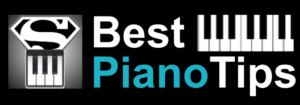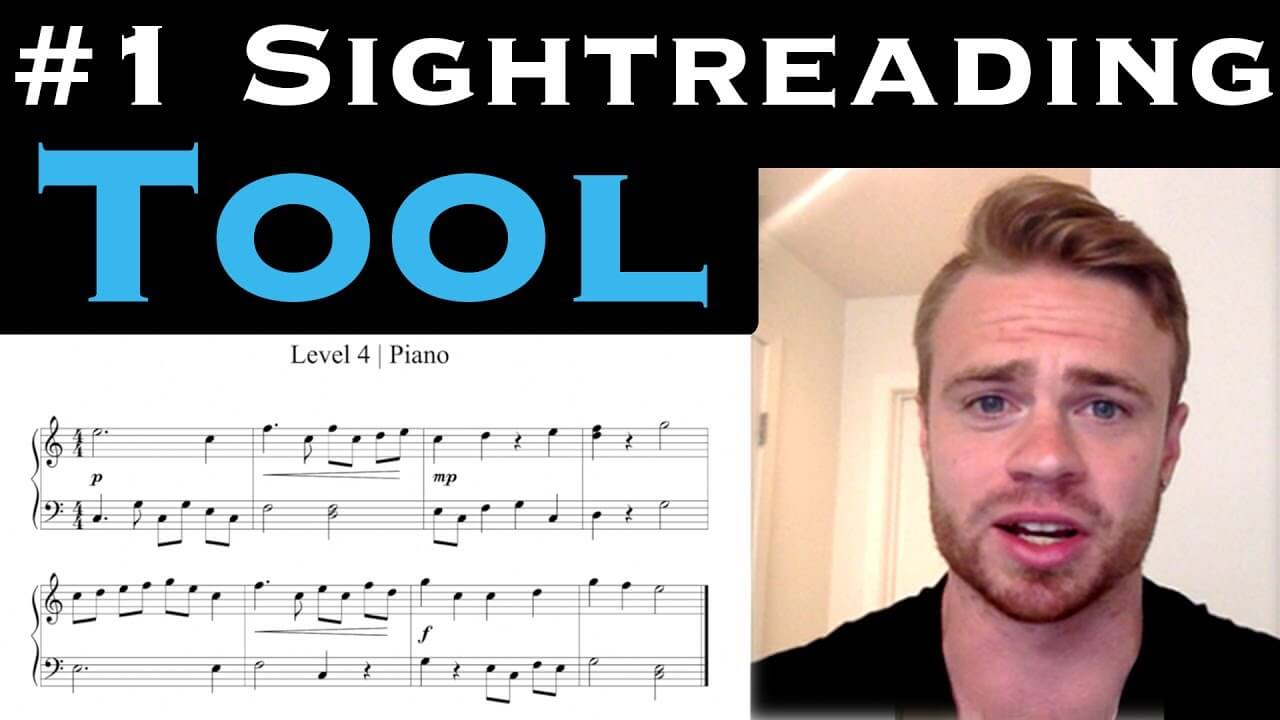Today I want to talk to you about what I consider the best sight reading software on the market – Sight Reading Factory. I WISH this had been around when I was first learning piano. This is the first software I found that systematizes sight reading, making it much faster to learn.
In this blog post I’m going to tell you about a sight reading workout plan to systematically go through each key and improve your sight reading over time. First, there is a concept I’m going to discuss that’ll be really beneficial to you.
The Zone of Optimal Development
In psychology there is a concept called “The Zone of Optimal Development” and basically there is stuff “inside your circle” that you already know and there is stuff “outside your circle” and the farther outside your circle the harder it is to learn.
I used to just kind of print out random sheet music and the problem was that it’d either be way too easy (Inside my circle) or way too hard (Too far outside my circle).
Think of it like weight lifting. If you can lift 100 pounds now, you want to increase slightly to maybe 105 or 110 pounds to get stronger. You want something that is challenging, just outside your comfort zone, but not too difficult where you can’t do it at all.
Same thing with sight reading – you want something that’s a little harder than what you can handle now. Then, you can progress from there.
Digging Into the Sight Reading Software
Let’s get into the actual system of this software to show you what it can do. If you want to follow along visually, check out the video I made for it.
First, you can choose the instrument. For us, we’re going to choose piano.
Next, and this is what I really love, you can choose the level. The software has levels from ½ to 8 and you can see that as the levels progress they slowly and systematically add more rhythms.
When it comes to leaps, the same concept is applied. As you progress from one level to the next you’ll notice it slowly and gradually adds leaps. This is really helpful so you don’t get frustrated as you’re trying to learn sight reading.
One more thing it has, is it starts with hands separate and gradually progresses to hands together. This progression is something I’ve talked about before and I really love that it’s included in the software.
Going Through an Example
Let’s say you’re at a level 4. You can click on the level 4 button and you’re able to choose the number of measures, which is incredibly helpful and something I really like.
I remember when I used to try to sight read and I’d play these very long songs. I’d get 14 or 15 measures in and I’d start losing it. I’d lose the sight reading and get frustrated because it’s really hard to get back on track. I think it’s much more efficient to play small examples. You’d play a very small example and then reset and do the same thing over and over again.
So, once you’ve chosen the number of measures, you’ll just press the start button and it’ll give you a very small example at that level 4 difficulty. This is really nice because you can play through this example and then just choose another one.
Also, if you go back to those settings you can choose “Time Signature” and even pick your key. So you could plan it where you stick to a 4/4 time signature and then pick a C major key to work on for the week. This makes it easier at the start and you can gradually add in more key signatures over time. I go over this a bit more when I talk about the long-term plan I mentioned earlier.
Another cool thing I really love is you can do the metronome here. You just set the metronome to the tempo you want, hit start, and you can play through the metronome. It’ll actually play the song too, but I prefer to turn it off. You can also start it very slow and gradually ramp up the tempo.
We were doing “Regular Practice Mode”, but if you go back to the settings you can also go to “Timed Practice Mode.” What I like about this is that it’s very specific to your situation. Let me give you an example.
Let’s say you play for a choir. In an actual circumstance, the choir teacher is handing out new music, he gives you the music, but he’s also handing it out to other students and maybe he’s talking to people about the piece. You might have, on average, three minutes before you start playing. You can set the countdown timer to three minutes, hit start, and you’ll have the three minute countdown begin. That means you’ll have three minutes to analyze the piece, work it through your fingers, and once the timer stops you have to sight read it at the beats per minute you chose. It’s very specific to what you’ll actually be doing in real life.
Another thing that’s cool is the disappearing measures. This isn’t a necessary step, but I think it’s a more fun way to do things. It’s also a real-life situation because you can’t go back – the measure disappears as you complete it. If we mess up, we tend to want to go back and repeat the measure, but in real life, if you mess up, the singers keep singing or whoever you’re playing with will keep playing.
The software also has a setting where you can set a cursor that’ll show you exactly where you should be in the song. I tried this, but I just found it more distracting and annoying than anything else. Give it a shot though and see if you like it.
The Long Term Workout Plan
I love systematizing things – scales, technique, and everything. With sight reading it’s no different. Take the key of C and MASTER it until it’s rock solid. Then, move on to the next key, and the next, and so on. Do this for one week each.
Using a spreadsheet is an easy way to organize your practice. I use one with columns that start with the key on the far left and then have each level from the software, ½ to 8, as you move to the right. The video demonstration for this part can be found here.
So, the first key might be C and if I can play it at Level ½ I mark that off on my sheet by making the cell green. If I can play it at Level 1 I mark that off on the sheet as well in green. I’ll do this for each level until I get to the one that’s challenging and I need to practice more on. For that level I’ll make the cell yellow.
Each week you’ll move down the sheet to a different key, repeating the process and seeing which level you can get to for each key. You’ll do this for 12 weeks and what will happen, after going through all the different keys, is that you’ll come back to the key of C and notice you’re already a level or two higher because you’ve played other keys which were more difficult.
It’s way faster to go through a system like this than just print off random sheet music from the internet. Also, the first time you use this system, take one key per week and then practice everything in that key – your scales, your arpeggios, your finger drills, and your sight reading. You’re hitting each key from so many angles because this will help your brain internalize the key so you’ll learn it much better.
One thing you can do if you go through the first time and the sight readings start to get easy in the key of C is take two keys each week instead of one. This starts to get harder as you have to think about more than one key, but it’s still easier than trying to learn all 12 keys at once.
The third time you go through the system maybe you focus on three keys per week. By the fourth time you might shift between six keys per week. When you’ve gone through this a fifth time you may be shifting through all twelve.
Remember, this is a long term process. It might take you six months before you’re getting through every single key, but once you’ve done it, once the entire sheet is green, you know that your sight reading is good. You can always improve more of course, but after going through this systematically you can pretty much say you’ve mastered sight reading.
Combining Subskills to Fully Grasp Sight Reading
Sight reading is basically a set of subskills. One of them is to be able to read through a piece really fast and find patterns so they’re easier to play. Another subskill is playing without stopping and forcing your brain to keep playing even when you make mistakes. Keyboard topography is another skill, where you can find the notes without looking down so you can spend more time looking at the sheet music and reading ahead. Reading notes as chords is another subskill.
What a lot of people do is just sight read and play through the example a hundred times. I used to do that all the time too. What would happen though is that I’d constantly look down at my hands and never develop the skill of keyboard topography and feeling the keyboard. Since I would always look down, it became a crutch. I’d use other skills to compensate for it, but eventually I’d hit this sticking point when the sight reading got hard enough and there was no way I had time to look up and down.
I suggest you do a few things when you sight read a piece:
- Scan the piece and look for patterns
- Play through without stopping using a metronome
- Play again without looking down
- Play and verbalize every chord being played (More advanced)
You play each example three times, going through different examples for more practice.
If you’re serious about learning piano, Sight Reading Factory is the best thing on the market and I’d HIGHLY SUGGEST it. It’s really affordable and makes your learning MUCH easier. I normally don’t promote other products, but this is by far the best product for sight reading I’ve come across and I’m excited to share it with you!

